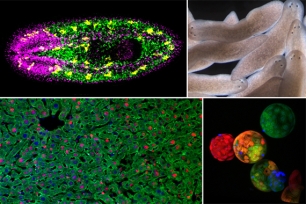Low oxygen levels prevent X chromosome inactivation in human embryonic stem cells
CAMBRIDGE, Mass. – Oxygen levels in the lab can permanently alter human embryonic stem (ES) cells, specifically inducing X chromosome inactivation in female cells, according to Whitehead Institute researchers. Human ES cells have been routinely created and maintained at atmospheric levels of oxygen, which is about 20%. Cells in the body are usually exposed to only 1-9% oxygen.
“When human ES cells are isolated at 20% oxygen, they are stressed and they inactivate one X chromosome in female cells,” says Founding Whitehead Member Rudolf Jaenisch. “This argues that the conventional way to make human ES cells is not optimal. We’re not saying our method is the only way or the best possible way, but it is better than the conventional method.”
These results are published in this week’s online issue of Cell.
Scientists are interested in human ES cells because they have the ability to mature into almost any cell type in the body, a trait known as pluripotency. Theoretically, this potential could be used to treat diseases or injuries.
“Also, human ES cells are the only tool we have to study the beginning of human development,” says Maisam Mitalipova, Director of the Whitehead Human Stem Cell Facility and designer of the study reported in Cell.
But human ES cells, even from the same cell lines, have been yielding different results in experiments. Inconsistent results may call into question an experiment’s methods or conclusions.
“The huge variation from lab to lab in culturing and isolating ES cells is one of the big problems in the field,” says Christopher Lengner, first author of the Cell paper and a postdoctoral researcher in the Jaenisch lab. “Just because of their growing conditions, the cells can be completely different from each other. So, we wanted to get back to the basics and really establish a ground state for how we isolate these cells and how we maintain them in the most pristine way possible.”
Human ES cells are usually derived from fertilized eggs that were designated for research by patients of in vitro fertilization (IVF) clinics. After an embryo grows to a ball of about 100 cells, researchers remove the ES cells. Traditionally, all of this work, from creating the fertilized eggs at the IVF clinic to the isolation and maintenance of the human ES cells in the lab, has been performed at atmospheric levels of oxygen. The resulting human ES cells display multiple differences in their genomes indicating they are at a slightly less flexible and pluripotent state than are mouse ES cells.
For example, after early random inactivation, female human ES cells always have the same X chromosome inactivated while mouse ES cells have two active X chromosomes until the cells begin differentiating, when one of the X chromosomes is randomly inactivated in each cell. X inactivation is vital for proper development in a female cell. If both X chromosomes are left active in an adult cell, the cell will have twice the expression of the X chromosome genes, which is fatal.
To test how oxygen levels during isolation and culture affect human ES cells, Mitalipova created six new human ES cell lines—two male and four female. Half of the cells isolated from each embryo were cultured in 20% oxygen, while the other half were created and maintained at 5% oxygen. The researchers then looked not only at the all of the genes expressed in these cells but also at their epigenetic state.
“When you expose the human ES cells to atmospheric oxygen for just a few days, the whole genome goes crazy – there are massive gene expression changes,” says Lengner.
But after a period of time the human ES cells adapt to the atmospheric oxygen and almost all of these changes normalized again, except for the X inactivation gene XIST, which remained strongly switched on. When Alexander Gimelbrant, who is Assistant Professor at Dana Farber Cancer Institute and co-first author of the article, checked, the female human ES cells exposed to 20% oxygen had one X chromosome permanently inactivated. However, the human ES cells derived at 5% oxygen did not exhibit the strong activation of the XIST gene, and both X chromosomes in the female cells remained active--an indication that these cells were in a more developmentally pristine state than their counterparts cultured in atmospheric oxygen.
Although this work focused on the effects of environmental oxygen levels, other factors may have similar negative effects on human ES cells.
“It seems that stress in general, like inefficiently freezing cells in the laboratory or embryos at the IVFclinic or manipulating the cells a lot, can make the cells inactivate an X chromosome and lose some pluripotency,” says Mitalipova.
Even if these stressors, including a high oxygen level, are eliminated, the human ES cells still are not as pluripotent as mouse ES cells.
However, in a paper published earlier this month in the Proceedings of the National Academy of Sciences (PNAS), Jacob Hanna in the Jaenisch lab describes two approaches to push existing and newly established human ES cells to the more pluripotent state seen in mouse ES cells. Hanna’s methods rely either on genes inserted into the ES cells’ DNA or on drugs added to the culture medium surrounding the cells, which appears to keep human ES cells in the more pluripotent state.
This research was supported by Hillel and Liliana Bachrach and Susan Whitehead.
* * *
Rudolf Jaenisch’s primary affiliation is with Whitehead Institute for Biomedical Research, where his laboratory is located and all his research is conducted. He is also a professor of biology at Massachusetts Institute of Technology.
* * *
Lengner, C. et al. “Derivation of pre-X inactivation human embryonic stem cells under physiological oxygen concentrations." Cell, online May 13, 2010.
Hanna, J. et al. “Human embryonic stem cells with biological and epigenetic characteristics similar to those of mouse ESCs." PNAS, May 3, 2010.
Topics
Contact
Communications and Public Affairs
Phone: 617-452-4630
Email: newsroom@wi.mit.edu


